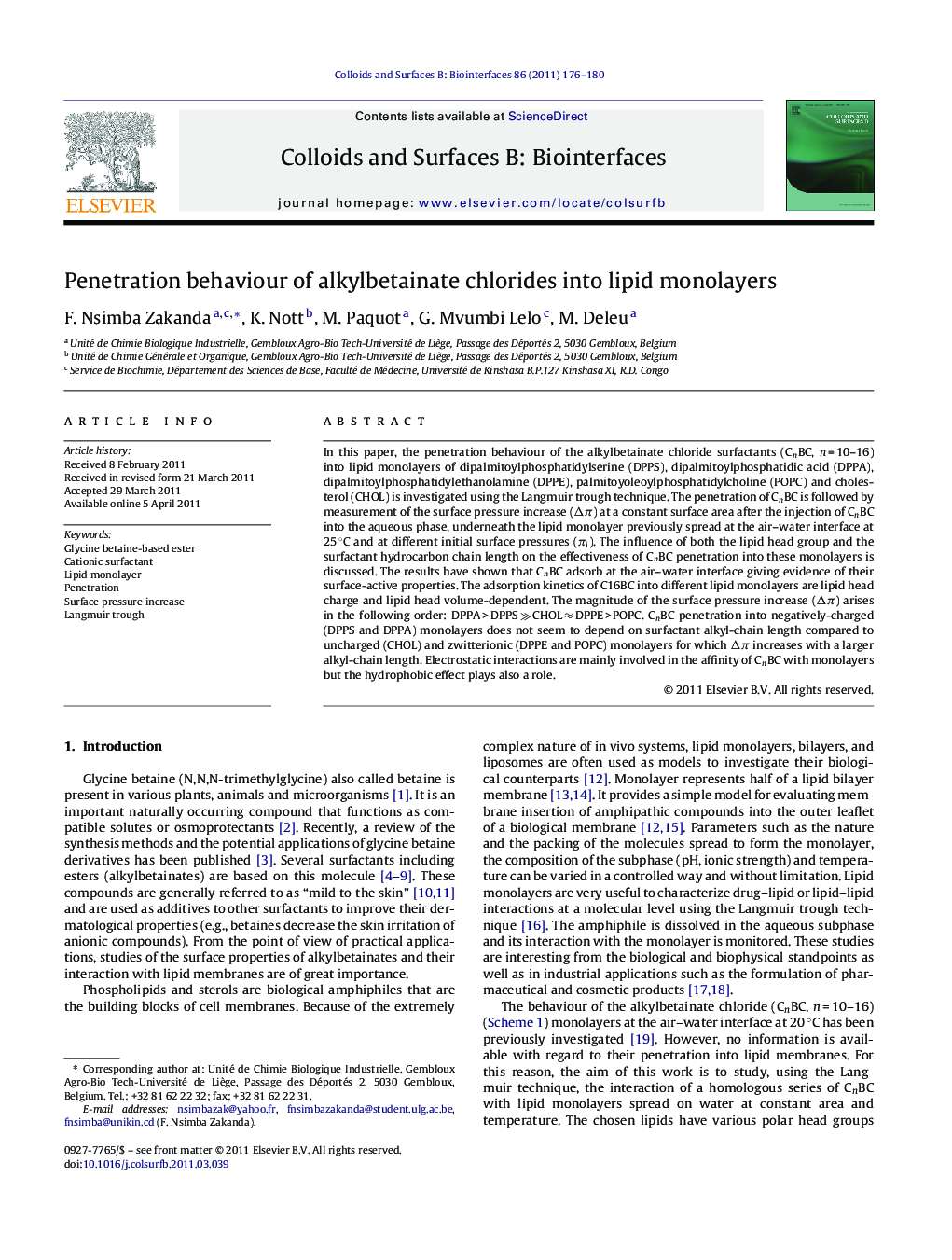| کد مقاله | کد نشریه | سال انتشار | مقاله انگلیسی | نسخه تمام متن |
|---|---|---|---|---|
| 601296 | 879938 | 2011 | 5 صفحه PDF | دانلود رایگان |

In this paper, the penetration behaviour of the alkylbetainate chloride surfactants (CnBC, n = 10–16) into lipid monolayers of dipalmitoylphosphatidylserine (DPPS), dipalmitoylphosphatidic acid (DPPA), dipalmitoylphosphatidylethanolamine (DPPE), palmitoyoleoylphosphatidylcholine (POPC) and cholesterol (CHOL) is investigated using the Langmuir trough technique. The penetration of CnBC is followed by measurement of the surface pressure increase (Δπ) at a constant surface area after the injection of CnBC into the aqueous phase, underneath the lipid monolayer previously spread at the air–water interface at 25 °C and at different initial surface pressures (πi). The influence of both the lipid head group and the surfactant hydrocarbon chain length on the effectiveness of CnBC penetration into these monolayers is discussed. The results have shown that CnBC adsorb at the air–water interface giving evidence of their surface-active properties. The adsorption kinetics of C16BC into different lipid monolayers are lipid head charge and lipid head volume-dependent. The magnitude of the surface pressure increase (Δπ) arises in the following order: DPPA > DPPS ≫ CHOL ≈ DPPE > POPC. CnBC penetration into negatively-charged (DPPS and DPPA) monolayers does not seem to depend on surfactant alkyl-chain length compared to uncharged (CHOL) and zwitterionic (DPPE and POPC) monolayers for which Δπ increases with a larger alkyl-chain length. Electrostatic interactions are mainly involved in the affinity of CnBC with monolayers but the hydrophobic effect plays also a role.
Penetration of alkylbetainate chloride surfactants (CnBC, n = 10–16) into lipid monolayers spread onto water at 25 °C has been studied. Langmuir trough technique was used to study the adsorption process. CnBC show faster and higher penetration into negatively-charged DPPS and DPPA than into uncharged CHOL and zwitterionic DPPE and POPC The magnitude of penetration into zwitterionic monolayers is in the following order: DPPE > POPC.Figure optionsDownload as PowerPoint slideHighlights
► Penetration of glycine betaine based esters, alkylbetainate chloride surfactants (CnBC, n = 10–16) into spread lipid monolayers onto water at 25 °C is investigated.
► Penetration is faster and higher into negatively-charged DPPS and DPPA than into uncharged CHOL and zwitterions DPPE and POPC.
► The magnitude of penetration is higher into DPPE than into POPC and may be related to the great cross-sectional and the bulky polar group of POPC than DPPE.
► Penetration turns out to be not alkyl-chain length-dependent for DPPS and DPPA than it is for CHOL, DPPE and POPC.
► Electrostatic interactions are mainly involved in the affinity of CnBC with lipids in the monolayers but the hydrophobic effect plays also a role.
Journal: Colloids and Surfaces B: Biointerfaces - Volume 86, Issue 1, 1 August 2011, Pages 176–180